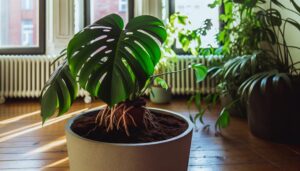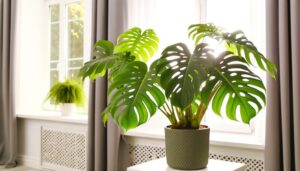Monstera Standleyana Aurea Vs Albo
When comparing Monstera standleyana 'Aurea' and 'Albo', you'll see distinct variegation patterns. 'Aurea' exhibits vibrant yellow splashes due to specific chlorophyll distribution, while 'Albo' features striking white patches resulting from chlorophyll absence.
Leaf size differs, with 'Aurea' typically producing larger leaves than 'Albo'. Both thrive in bright, indirect light but 'Albo' requires more careful light management to maintain its variegation.
Proper humidity, around 60%, is essential for best growth. Whether it's leaf morphology or photosynthetic efficiency, these differences enhance their unique appeal.
Understanding these details can help you choose the ideal plant for your collection.
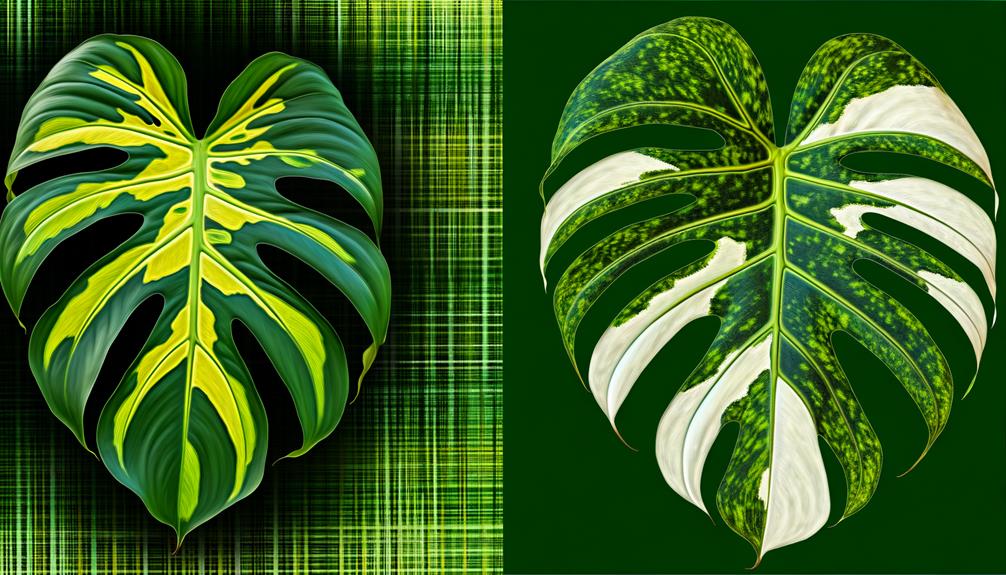
Key Takeaways
- Monstera standleyana 'Aurea' has vibrant yellow splashes, while 'Albo' features striking white patches.
- 'Aurea' retains more chlorophyll, resulting in better photosynthesis compared to 'Albo'.
- 'Aurea' typically produces larger leaves than 'Albo'.
- Both require bright, indirect light and high humidity for optimal growth.
- 'Aurea' offers a robust look with larger leaves, whereas 'Albo' provides a delicate, elegant appearance.
Origin and History
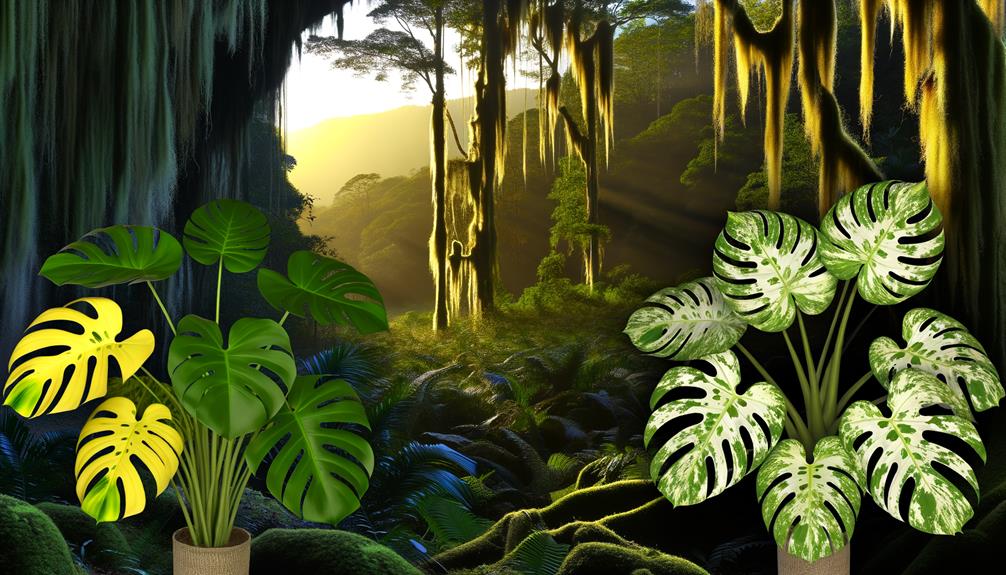
Monstera standleyana 'Aurea' and Monstera standleyana 'Albo' both originate from the tropical rainforests of Central America, particularly thriving in the dense, humid canopies. You'll find these epiphytic plants commonly clinging to trees, leveraging their aerial roots for support and nutrient absorption.
Their natural habitat offers consistent warmth and high humidity, essential for their growth. Documented by botanists for their unique variegation, these species are prized in horticultural circles. M. standleyana was first classified by Louis Otho Williams in the 1950s, with subsequent cultivars 'Aurea' and 'Albo' gaining popularity among collectors.
Understanding their origins helps you replicate their ideal conditions, ensuring robust growth and vibrant foliage in your own indoor or outdoor garden setups.
Leaf Coloration
Leaf coloration in Monstera standleyana 'Aurea' and Monstera standleyana 'Albo' presents distinct variegation patterns, with 'Aurea' showcasing vibrant yellow splashes and 'Albo' featuring striking white patches.
In Monstera standleyana 'Aurea', the chlorophyll distribution results in irregular, golden-yellow gradients across the leaf surface, enhancing its ornamental appeal. Conversely, Monstera standleyana 'Albo' exhibits albinotic sections due to the absence of chlorophyll, creating stark, white variegation. This differentiation is essential for photosynthesis efficiency, as 'Aurea' retains more chlorophyll than 'Albo'.
Both cultivars possess elliptical, glossy leaves, but the variegation patterns provide unique aesthetic qualities. Be sure you provide adequate light to maintain these variegations, as insufficient light can weaken the contrasting colors and reduce the plant's overall vibrancy.
Growth Patterns
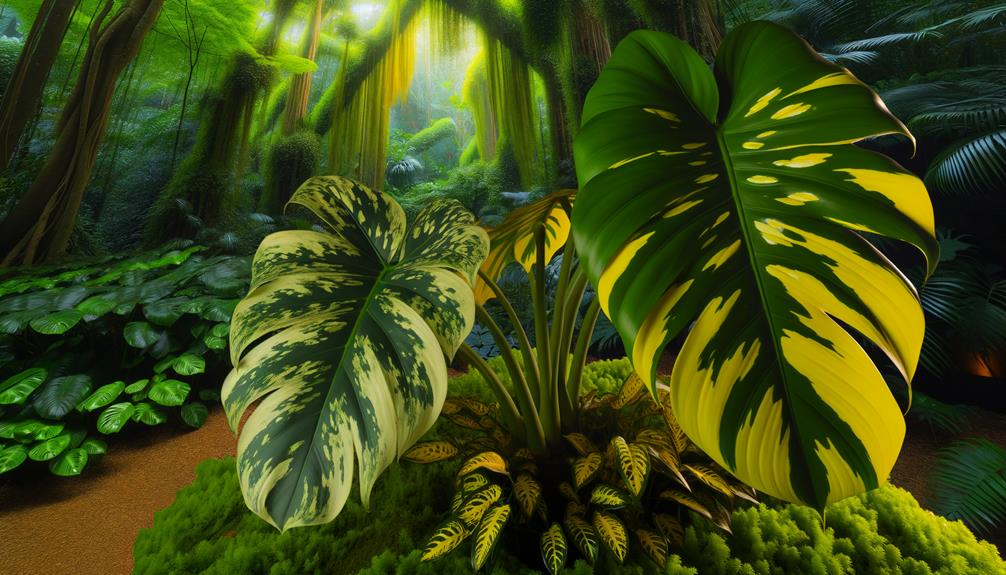
When comparing Monstera standleyana 'Aurea' and 'Albo', you'll notice distinct differences in leaf size, with 'Aurea' typically producing larger leaves.
Variegation stability also sets them apart; 'Albo' demonstrates a more consistent variegation pattern, whereas 'Aurea's' variegation can fluctuate.
These factors greatly influence their growth rates and overall visual appeal.
Leaf Size Differences
In comparing the growth patterns of Monstera standleyana 'Aurea' and 'Albo', one immediately notices that M. standleyana 'Aurea' typically produces slightly smaller leaves with a more consistent variegation pattern. The distinct differences in leaf size and growth can be attributed to the plant's genetic predispositions and environmental responses. M. standleyana 'Aurea' leaves tend to be more compact, while M. standleyana 'Albo' often exhibits larger, more expansive foliage. This variance can influence your decision when choosing between the two for ornamental purposes.
| Characteristic | 'Aurea' | 'Albo' |
|---|---|---|
| Leaf Size | Smaller | Larger |
| Growth Habit | Compact | Expansive |
| Variegation Pattern | Consistent | Variable |
| Foliage Appearance | Dense | Broad |
Understanding these differences helps optimize care and placement in your space.
Variegation Stability
Due to its genetic composition, Monstera standleyana 'Aurea' displays more stable variegation patterns compared to the often unpredictable variegation seen in Monstera standleyana 'Albo'.
You'll notice that 'Aurea' maintains a consistent yellow-green variegation, which indicates a stable chlorophyll mutation. This stability guarantees a predictable aesthetic, essential for collectors.
Conversely, 'Albo' features white variegation that can fluctuate significantly, resulting in inconsistent growth patterns. This variability arises from the chimeric nature of the variegation, leading to potential reversion or uneven distribution of white and green sectors.
Understanding these growth patterns is crucial for proper care. Make sure you provide optimal light conditions to maintain the desired variegation in both varieties, but especially for the more temperamental 'Albo'.
Light Requirements
Monstera standleyana 'Aurea' and Monstera standleyana 'Albo' both thrive under bright, indirect light, as direct sunlight can scorch their variegated leaves. These plants utilize filtered light to maintain their unique variegation and overall health.
| Light Conditions | Monstera standleyana 'Aurea' | Monstera standleyana 'Albo' |
|---|---|---|
| Best Light | Bright, indirect | Bright, indirect |
| Tolerance | Low light conditions | Low light conditions |
| Risks | Leaf scorch in direct sun | Leaf scorch in direct sun |
| Variegation | Enhances with bright light | Enhances with bright light |
| Growth Rate | Moderate in best light | Moderate in best light |
Place them near an east or north-facing window. Too little light can cause leggy growth, while too much can lead to leaf burn. Adjust your plant's position to strike a balance.
Watering Needs
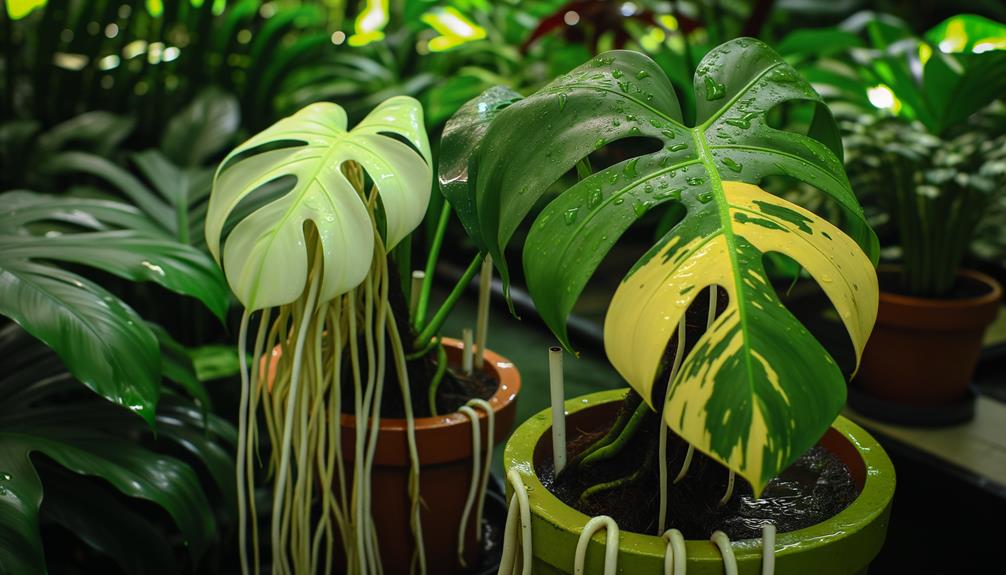
When caring for Monstera standleyana 'Aurea' and 'Albo', make certain you maintain consistently moist soil without allowing it to become waterlogged. Water these plants when the top inch of soil feels dry to the touch.
Overwatering can lead to root rot, a common issue in Monstera species. Use a watering can with a fine spout to deliver water evenly and avoid wetting the foliage. Guarantee your pot has adequate drainage holes to prevent water accumulation.
Monitor the humidity levels around your Monstera; they thrive in environments with 60% humidity or higher. If necessary, use a humidifier or a pebble tray with water to increase ambient moisture, especially during dry seasons or in air-conditioned spaces.
Soil Preferences
For ideal growth, Monstera standleyana 'Aurea' and 'Albo' require a well-draining soil mix rich in organic matter such as sphagnum peat moss, perlite, and orchid bark. This specific blend guarantees optimal aeration and moisture retention, essential for the health of these climbing aroids. You'll want to focus on the following components:
- Sphagnum peat moss: Enhances moisture retention while providing acidity.
- Perlite: Improves soil aeration and prevents compaction.
- Orchid bark: Adds structure, promoting root health and aeration.
- Activated charcoal: Maintains soil freshness and prevents root rot.
A balanced mix of these ingredients supports the Monstera's root system, ensuring strong growth and vibrant variegation. Proper soil composition is necessary for nutrient uptake and overall well-being.
Temperature Tolerance
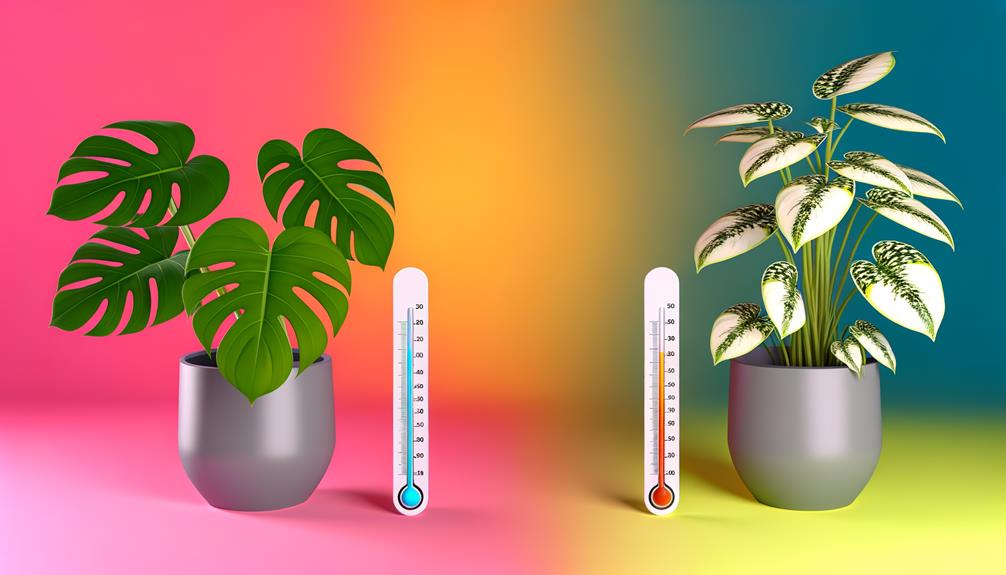
Surprisingly, the Monstera standleyana 'Aurea' and 'Albo' thrive most in temperatures ranging from 65°F to 85°F (18°C to 29°C), displaying ideal growth and variegation within this range.
These tropical plants, native to Central and South America, exhibit peak physiological processes under these conditions. Deviations below 65°F can cause slowed photosynthesis and growth, while temperatures above 85°F may lead to heat stress and potential leaf damage.
Monitor ambient temperatures closely, especially during seasonal changes. Extreme fluctuations should be avoided to maintain consistent metabolic activities.
Implementing temperature control measures, such as using thermostats and avoiding direct drafts, can help optimize your Monstera standleyana 'Aurea' and 'Albo' thrive, showcasing their distinctive variegated foliage.
Humidity Levels
Maintaining high humidity levels, ideally between 60% and 80%, is important for the Monstera standleyana 'Aurea' and 'Albo' to exhibit optimal growth and vibrant variegation. These conditions mimic their native tropical environments, promoting best physiological processes.
To achieve this, consider the following methods:
- Use a humidifier: This ensures consistent humidity levels.
- Group plants together: Increases ambient moisture through transpiration.
- Place on a humidity tray: Enhances localized humidity around the plant.
- Mist regularly: Provides immediate, though temporary, humidity boost.
It's essential to monitor humidity levels, as insufficient moisture can lead to browning leaf edges and reduced variegation. Conversely, excessive humidity may promote fungal diseases.
Regular checks with a hygrometer can help maintain the ideal environment.
Propagation Methods
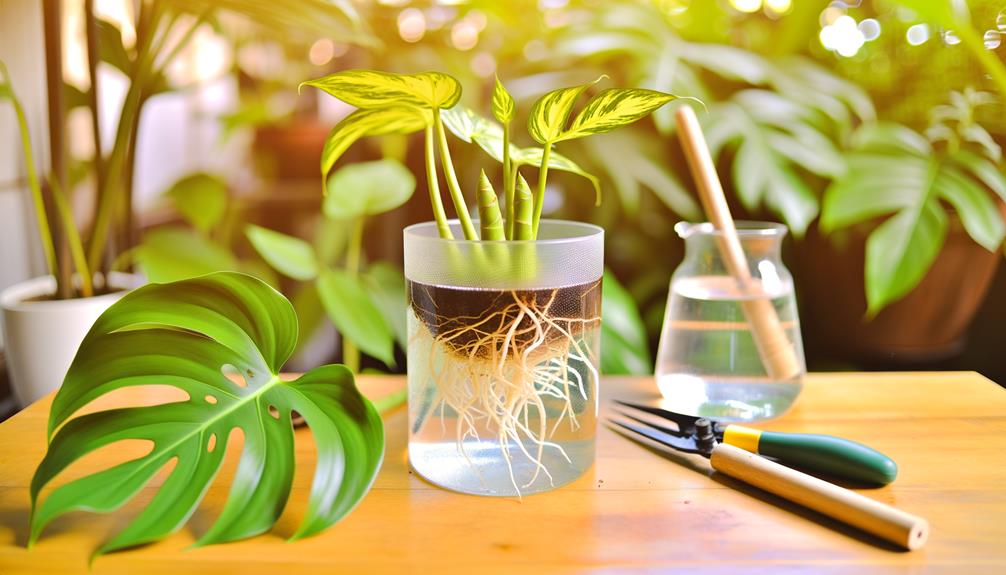
To propagate Monstera standleyana 'Aurea' and 'Albo', you can use stem cuttings to guarantee genetic consistency and maintain variegation. Start by selecting a healthy stem with at least one node and aerial root. Using sterilized scissors, make a clean cut below the node. Submerge the cut end in water or a well-draining soil mix to encourage root development.
Maintain high humidity and indirect light to optimize growth. Change the water every few days if using the water propagation method to prevent bacterial growth. Root development typically begins within 2-4 weeks. Once roots are established, transplant the cutting into a suitable potting mix, ensuring it receives adequate moisture and light for continued growth.
Common Pests
Monstera standleyana 'Aurea' and 'Albo' are susceptible to common pests like spider mites (Tetranychus urticae), mealybugs (Pseudococcidae), and scale insects (Coccoidea), which can cause significant damage to their foliage. You'll often find these pests feeding on the plant's sap, leading to chlorosis, stunted growth, and even necrosis.
To protect your Monstera, regularly inspect the leaves and stems for signs of infestation. Here's what to look for:
- Spider mites: Tiny, reddish spots and webbing on the underside of leaves.
- Mealybugs: Cotton-like masses, usually at leaf nodes and undersides.
- Scale insects: Brown, waxy bumps that are often immobile.
- Aphids: Small, green or black insects clustered on new growth.
Early detection and intervention are essential for maintaining plant health.
Aesthetic Appeal
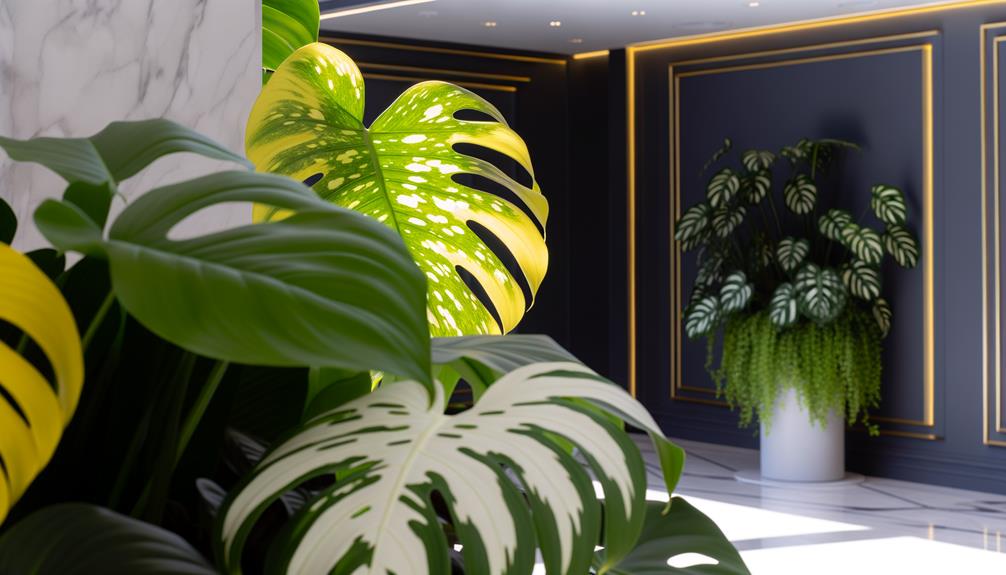
When observing Monstera standleyana 'Aurea' and 'Albo', you'll notice distinct differences in foliage color patterns and variegation consistency.
'Aurea' exhibits golden-yellow variegation, while 'Albo' features striking white patterns.
Additionally, leaf size variations between the two cultivars influence their overall aesthetic appeal.
Foliage Color Patterns
With their striking variegation, Monstera standleyana 'Aurea' and Monstera standleyana 'Albo' exhibit distinct foliage color patterns that captivate plant enthusiasts and collectors alike.
The Monstera standleyana 'Aurea' features yellow to light green variegation, providing a vibrant contrast against the dark green leaves.
In contrast, the Monstera standleyana 'Albo' showcases white to cream variegation, creating a more subtle, elegant appearance.
'Aurea' Variegation: Yellow to light green
'Albo' Variegation: White to cream
Contrasting Patterns: 'Aurea' is bold and vibrant, 'Albo' is subtle and elegant
Leaf Consistency: Both exhibit stable variegation patterns
Leaf Size Differences
In addition to their variegation patterns, you'll notice that Monstera standleyana 'Aurea' and Monstera standleyana 'Albo' also differ in leaf size, which contributes to their overall aesthetic appeal.
The leaves of Monstera standleyana 'Aurea' (scientific name: Monstera standleyana 'Aurea') typically exhibit a slightly larger and broader structure compared to Monstera standleyana 'Albo' (scientific name: Monstera standleyana 'Albo'). This difference in leaf size can affect the plant's visual impact in your space. The 'Aurea' tends to create a more robust and lush appearance, while the 'Albo' offers a refined and delicate aesthetic.
These variations in leaf morphology not only enhance their individual beauty but also cater to diverse horticultural preferences, making each cultivar unique in its own right.
Variegation Consistency
Variegation consistency greatly impacts the aesthetic appeal of Monstera standleyana 'Aurea' and Monstera standleyana 'Albo', as the stable, predictable patterns in 'Aurea' offer a uniform appearance, while the more sporadic variegation in 'Albo' provides a unique, artistic touch.
With Monstera standleyana 'Aurea', you'll notice:
- Uniform distribution of yellow variegation: Maintains a balanced look.
- Predictable patterning: Offers a consistent, symmetrical appearance.
- Stable genetic expression: Reduces the likelihood of reversion.
- Enhanced light reflection: Heightens the visual appeal in low-light conditions.
In contrast, Monstera standleyana 'Albo' boasts unpredictable white variegation, creating a more dramatic and striking aesthetic. The irregular patterns can vary from leaf to leaf, making each one a unique piece of living art.
Choosing the Right Plant
When choosing between Monstera standleyana 'Aurea' and Monstera standleyana 'Albo', evaluate their variegation patterns and growth requirements to determine which fits your environment and aesthetic preferences. The 'Aurea' variety exhibits yellow variegation, while the 'Albo' features white variegation. Consider the lighting conditions in your space, as 'Aurea' thrives in bright, indirect light but can tolerate lower light levels better than 'Albo'. For cultivation, both require well-draining soil and a humid environment.
| Aspect | Monstera standleyana 'Aurea' | Monstera standleyana 'Albo' |
|---|---|---|
| Variegation Color | Yellow | White |
| Light Requirements | Bright, indirect; tolerates lower light | Bright, indirect |
| Growth Rate | Moderate | Moderate |
Choose the variety that aligns with your specific conditions and visual preferences.
Conclusion
You've now journeyed through the intricacies of Monstera standleyana 'Aurea' and 'Albo'. Each plant, with its unique variegation and growth habits, beckons like a siren's song.
'Aurea' dazzles with golden hues, while 'Albo' enchants with its alabaster splashes. From light to water, their needs are specific yet rewarding.
Whether you're captivated by the vibrant Aurea or the elegant Albo, your choice will add a touch of botanical splendor to your collection.




